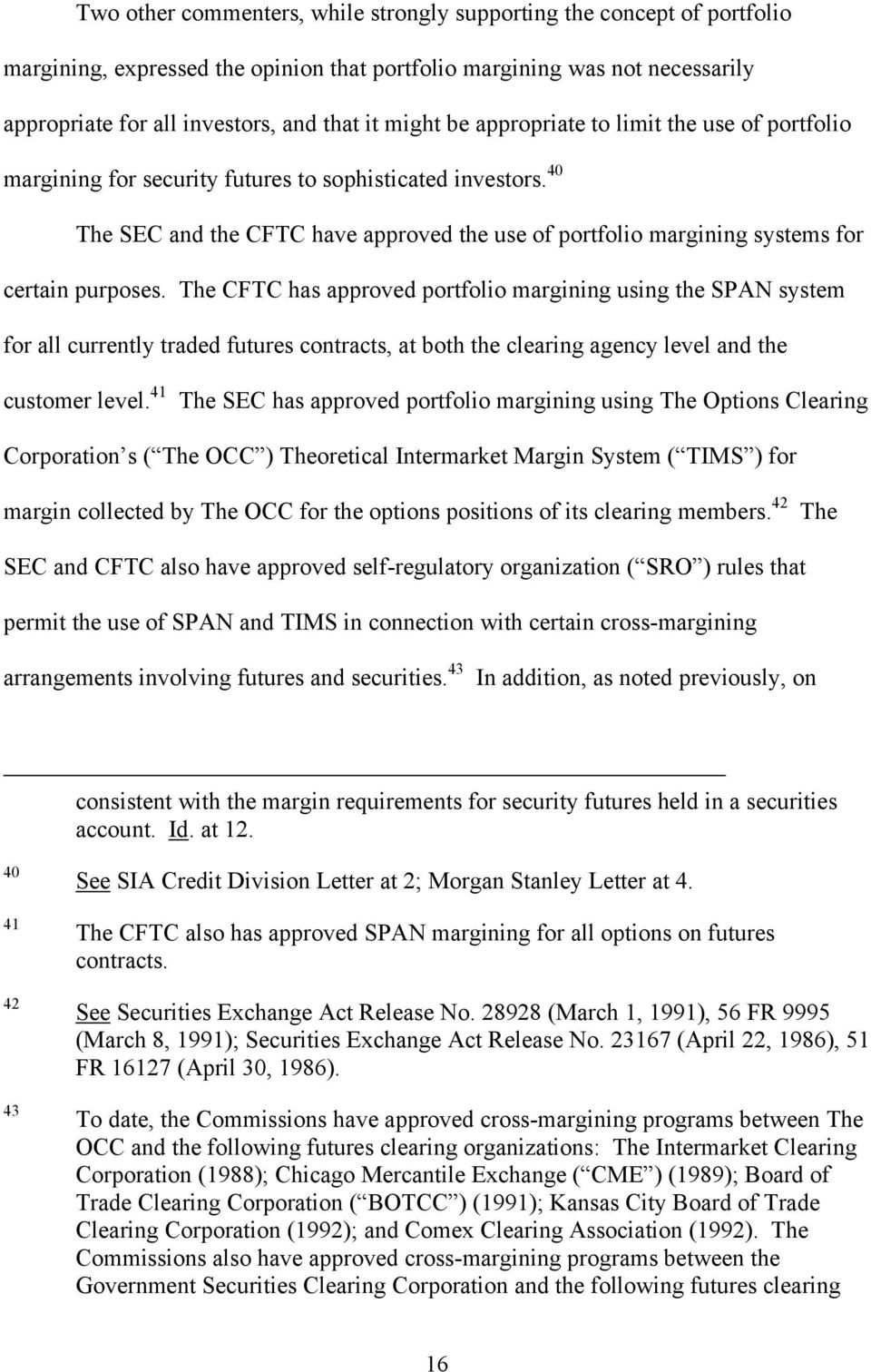Fintech
At Joint Open Meeting, SEC and CFTC Approve Final Rule on Security Futures Margin and Request for Comment on Portfolio Margining

Washington D.C.–(Newsfile Corp. – October 22, 2020) – The Securities and Exchange Commission and the Commodity Futures Trading Commission, at their first joint open meeting to vote on rulemaking initiatives, today approved: (1) a joint final rule to harmonize the minimum margin level for security futures held in a futures account with the minimum margin level for security futures held in a securities portfolio margin account, and (2) the issuance of a joint request for comment on the portfolio margining of uncleared swaps and non-cleared security-based swaps.
The joint final rule and request for comment are two components of the Commissions’ ongoing efforts to further harmonize their regulatory regimes to better serve the markets and investors.
“Collaboration and coordination between the two Commissions are critical to achieving our shared regulatory objectives,” said SEC Chairman Jay Clayton. “I want to express my thanks to my colleagues at both the SEC and CFTC for their hard work, and I look forward to continuing to work together to improve our markets, including exploring potential opportunities for efficiencies in portfolio margining.”
“The markets the CFTC and SEC regulate are highly interconnected, so coordination is vital to regulatory effectiveness. The historic joint open meeting of our two agencies reflects our strong commitment to cooperation and harmonizing our efforts where appropriate,” said CFTC Chairman Heath P. Tarbert. “Today’s final rule represents an important example of our long history of cooperation regarding the joint regulation of security futures. I am pleased that the Commissions will continue this collaboration to examine potential ways to implement the portfolio margining of uncleared swaps and non-cleared security-based swaps.”
***
FACT SHEET
Joint Final Rule: Customer Margin Rules Relating to Security Futures
October 22, 2020
Action
The joint final rule will harmonize the minimum margin level for security futures, whether they are held in a futures account, a securities portfolio margin account, or a securities account that is not approved for portfolio margining.
Highlights of the Action
The Commissions have joint rulemaking authority regarding margin requirements for security futures. In 2002, the Commissions adopted rules establishing margin levels for unhedged security futures at 20 percent. In light of the asymmetry in margin requirements resulting from the 15 percent margin level that has been established for security futures and comparable financial products held in a securities portfolio margin account, the Commissions are adopting the proposed margin requirement to set the required margin level for each long or short unhedged position in a security future at 15 percent of its current market value.
At this time, there are no security futures contracts listed for trading on U.S. exchanges. The final rule amendments, however, would set a 15 percent level for security futures if an existing exchange were to resume operations or another exchange were to launch security futures contracts.
What’s Next?
This final rule is effective 30 days after publication in the Federal Register.
***
FACT SHEET
Joint Request for Comment: Portfolio Margining of Uncleared Swaps and Non-Cleared Security-based Swaps
October 22, 2020
Action
The joint request for comment seeks public input on potential ways to implement portfolio margining of uncleared swaps and non-cleared security-based swaps, including whether there are opportunities to enhance efficiencies, reduce complexity, increase consistency and add resiliency to our financial system through adjustments to our current margin rules.
Highlights of the Action
Portfolio Margining
Portfolio margining generally refers to the cross margining of related positions in a single account. Portfolio margining of uncleared swaps, non-cleared security-based swaps, and related positions can offer benefits to customers and the markets, including promoting greater efficiencies in margin calculations with respect to offsetting positions. At the same time, facilitating portfolio margining for uncleared swaps, non-cleared security-based swaps, and related positions requires careful consideration to ensure that any customer protection and applicable regulatory issues and potential impacts are appropriately considered and addressed.
Regulation of Non-Cleared Security-based Swaps and Uncleared Swaps
Under the Dodd-Frank Act, the CFTC has jurisdiction over uncleared swaps and the SEC has jurisdiction over non-cleared security-based swaps. The CFTC has adopted margin rules (including minimum standards for the safekeeping of collateral) for uncleared swaps applicable to nonbank swap dealers and the SEC has adopted margin and segregation rules applicable to nonbank security-based swap dealers. As discussed in the request for comment, the requirements of these rules differ in some ways that would be relevant to portfolio margining.
The following table summarizes some of the similarities and differences between the agencies’ margin rules:
|
Requirement |
SEC Margin Rule for Non-Cleared Security-based Swaps |
CFTC Margin Rule for Uncleared Swaps |
|
Dealer Must Collect/Post Variation Margin |
Required, unless exception |
Required, unless exception |
|
Dealer Must Collect Initial Margin |
Must collect from all counterparties, unless a counterparty, threshold or legacy exception applies |
Required collection from other swap dealers and financial end users with material swaps exposure, unless a counterparty threshold or legacy exception applies |
|
Dealer Must Post Initial Margin |
Permitted, but not required |
Required posting to other swap dealers and financial end users with material swaps exposure, unless a counterparty threshold or legacy exception applies |
|
Dealer Can Use An Approved Initial Margin Model (including an industry standard model) |
Permitted; provided Broker-dealer/SBSDs must use a standardized method for equity security-based swaps |
Permitted |
|
Initial Margin Posted to/by Dealer Must Be Held by Third-Party Custodian |
Permitted, but not required |
Required |
|
Waiver of Segregation Requirements for Initial Margin Collateral |
Permitted; provided that, if the SBSD is a broker-dealer, non-affiliated customers cannot waive segregation |
Prohibited |
|
Re-hypothecation of Initial Margin Collateral |
Permitted under limited circumstances |
Prohibited |
Specific Requests for Comment; Different Account Types
The request for comment solicits comment on various specific aspects of the margining of uncleared swaps, non-cleared security-based swaps, and related positions, including on the merits, benefits, and risks of portfolio margining these types of positions, and on any regulatory, legal, and operational issues associated with portfolio margining these various positions in different account types.
The following table, organized by account type and position type, summarizes the current margin and segregation requirements that apply and the types of positions subject to our requests for comment:
|
Account Type |
Types of Positions Subject to Request for Comment |
Current Margin Requirements for Account Type |
Current Segregation Requirements for Account Type |
|
Broker-Dealer/SBSD Securities Account: Portfolio Margin |
– Uncleared swaps – Non-cleared security-based swaps – Cash market securities positions – Listed securities options – OTC securities options – Futures – Options on futures – Security futures |
– Securities self-regulatory organization (“SRO”) portfolio margin rules |
– Possession or control of fully paid and excess margin securities and excess securities collateral (SEC Rule 15c3-3) – Reserve account for excess credits (SEC Rule 15c3‑3) – Affiliates of broker-dealer can waive segregation for non-cleared security-based swaps -Counterparties to non-cleared security-based swap transactions can elect to have individual segregation at a third-party custodian. |
|
Broker-Dealer/SBSD Securities Account: Non-Portfolio Margin |
– Uncleared swaps – Non-cleared security-based swaps – Cash market securities positions – Listed securities options – OTC securities options – Futures – Options on futures – Security futures |
– Federal Reserve Board’s Regulation T – SRO margin rules – SEC margin rules for security futures |
– Possession or control of fully paid and excess margin securities and excess securities collateral (SEC Rule 15c3-3) – Reserve account for excess credits (SEC Rule 15c3‑3) – Affiliates of broker-dealer can waive segregation for non-cleared security-based swaps -Counterparties to non-cleared security-based swap transactions can elect to have individual segregation at a third-party custodian. |
|
Broker-Dealer/SBSD Security-Based Swap Account |
– Uncleared swaps – Non-cleared security-based swaps – OTC securities options – Related collateral |
– SEC Rule 18a-3 (Margin requirements for SBSDs) -SRO margin rules (for OTC securities options) |
– Possession or control excess securities collateral (SEC Rule 15c3-3) – Reserve account for excess credits (SEC Rule 15c3‑3) – Affiliates of broker-dealer can waive segregation for non-cleared security-based swaps -Counterparties to non-cleared security-based swap transactions can elect to have individual segregation at a third-party custodian. |
|
SBSD (including SBSD/OTC derivatives dealer) Security-Based Swap Account |
– Uncleared swaps – Non-cleared security-based swaps – OTC securities options – Related collateral |
– SEC Rule 18a-3 (Margin requirements for SBSDs) – Federal Reserve Board’s Regulation U (for OTC securities options) |
– Possession or control excess securities collateral for security-based swaps (SEC Rule 18a-4) – Reserve account for excess credits for security-based swaps (SEC Rule 18a‑4) – All counterparties can waive segregation for non-cleared security-based swaps or elect individual segregation at a third party custodian. |
|
Swap Dealer Swap Account |
– Uncleared swaps – Non-cleared security-based swaps – Related collateral |
CFTC Rules 23.150 – 23.161 (Margin requirements for swap dealers) |
Initial margin must be held at an independent third-party custodian (CFTC Rule 23.157) |
What’s Next
The public comment period will remain open for 30 days following publication in the Federal Register. All comments will be posted on both the CFTC’s website and the SEC’s website.
Fintech
Fintech Pulse: Daily Industry Brief – A Dive into Today’s Emerging Trends and Innovations

The fintech landscape continues to redefine itself, driven by innovation, partnerships, and groundbreaking strategies. Today’s roundup focuses on the latest digital wallet offerings, evolving payment trends, strategic collaborations, and notable funding achievements. This editorial explores the broader implications of these developments, casting light on how they shape the future of fintech and beyond.
Beacon’s Digital Wallet for Immigrants: A Gateway to Financial Inclusion
Beacon Financial, a leading player in financial technology, recently launched a digital wallet tailored to meet the unique needs of immigrants moving to Canada. This offering bridges a critical gap, enabling seamless financial integration for newcomers navigating a foreign system.
By combining intuitive technology with user-centric features, Beacon aims to empower immigrants with tools for payments, savings, and remittances. This aligns with the growing demand for tailored financial products that resonate with specific demographics.
Op-Ed Insight:
Financial inclusion is more than just a buzzword; it’s a moral imperative in the fintech space. Products like Beacon’s digital wallet highlight the industry’s potential to create tangible change. As global migration trends increase, such offerings could inspire similar initiatives worldwide.
Source: Fintech Futures.
Juniper Research Highlights 2025’s Payment Trends
Juniper Research’s latest report unveils pivotal payment trends poised to dominate in 2025. Central themes include the adoption of instant payment networks, a surge in embedded finance solutions, and the rise of crypto-backed financial products.
The research underscores the rapid adoption of real-time payment systems, fueled by increasing consumer demand for speed and efficiency. Meanwhile, embedded finance promises to blur the lines between traditional banking and non-financial services, delivering personalized and context-specific solutions.
Op-Ed Insight:
As the lines between financial services and technology continue to blur, these trends emphasize the industry’s shift toward convenience and personalization. The growing role of crypto-based solutions reflects an evolving consumer mindset, where decentralization and digital-first experiences gain precedence.
Source: Juniper Research.
MeaWallet and Integrated Finance Partner to Revolutionize Digital Wallets
MeaWallet, a prominent fintech solutions provider, has partnered with Integrated Finance to advance digital wallet capabilities and secure card data access for fintech companies. This collaboration focuses on empowering fintechs to deliver better, safer digital payment experiences.
MeaWallet’s role as a technology enabler aligns seamlessly with Integrated Finance’s goal of simplifying complex financial infrastructures. Together, they aim to create scalable, robust platforms for secure payment solutions.
Op-Ed Insight:
Partnerships like this underscore the importance of collaboration in driving innovation. As security concerns grow in tandem with digital payment adoption, solutions addressing these challenges are essential for maintaining consumer trust. The fintech ecosystem thrives when synergy and innovation coalesce.
Source: MeaWallet News.
Nucleus Security Among Deloitte’s Fastest-Growing Companies
Nucleus Security has achieved a remarkable milestone, ranking 85th on Deloitte’s 2024 Technology Fast 500 list. This achievement is attributed to its robust cybersecurity solutions, which cater to the increasingly digital fintech environment.
With cyberattacks becoming more sophisticated, fintech companies are under immense pressure to safeguard their platforms. Nucleus Security’s growth reflects the rising demand for comprehensive, scalable security solutions that protect sensitive financial data.
Op-Ed Insight:
In a digital-first world, robust cybersecurity isn’t optional—it’s fundamental. The recognition of companies like Nucleus Security signals the growing importance of protecting fintech infrastructure as the industry scales globally.
Source: PR Newswire.
OpenYield Secures Funding to Transform the Bond Market
OpenYield has announced a successful funding round, aiming to revolutionize the bond market through innovative technology. The platform promises greater transparency, efficiency, and accessibility in fixed-income investments.
This funding underscores the growing appetite for digitizing traditionally opaque financial markets. By leveraging cutting-edge technology, OpenYield seeks to democratize bond investments, making them accessible to a broader audience.
Op-Ed Insight:
The bond market, long viewed as complex and inaccessible, is ripe for disruption. OpenYield’s efforts to modernize this space highlight fintech’s transformative potential to democratize finance and empower individual investors.
Source: PR Newswire.
Key Takeaways: Shaping the Future of Fintech
Today’s developments underscore several critical themes in the fintech landscape:
- Personalization and Inclusion: Products like Beacon’s wallet highlight the importance of understanding and addressing specific user needs.
- Collaborative Ecosystems: Partnerships, like that of MeaWallet and Integrated Finance, emphasize the power of collaboration in solving industry challenges.
- Emerging Technologies: Juniper Research’s predictions affirm the continued influence of blockchain, embedded finance, and instant payment networks.
- Security at the Core: The recognition of Nucleus Security underscores the essential role of cybersecurity in fintech.
- Market Transformation: OpenYield’s funding signifies the ongoing disruption of traditional financial markets, paving the way for broader accessibility.
The post Fintech Pulse: Daily Industry Brief – A Dive into Today’s Emerging Trends and Innovations appeared first on News, Events, Advertising Options.
Fintech
Fintech Pulse: Industry Updates, Innovations, and Strategic Moves

As fintech continues to reshape the global financial landscape, today’s briefing highlights pivotal developments, strategic expansions, and innovative launches across the industry. This op-ed explores the latest advancements with commentary on their potential impacts and challenges.
Finastra Data Breach: A Wake-Up Call for Fintech Security
Source: KrebsOnSecurity
The cybersecurity landscape is buzzing after Finastra, one of the largest financial technology providers globally, confirmed an investigation into a potential data breach. Reports suggest unauthorized access to its systems, raising concerns about data security across its client base, which includes thousands of banks and financial institutions worldwide.
Implications and Challenges
While the details of the breach remain sparse, this incident underscores a glaring vulnerability in the fintech sector—cybersecurity. As financial services increasingly rely on interconnected ecosystems, breaches like these threaten not only individual institutions but also the trust customers place in fintech platforms.
The key takeaway for the fintech industry is clear: proactive cybersecurity strategies must go beyond compliance. Real-time threat detection, robust encryption standards, and regular audits are no longer optional but essential for maintaining operational integrity.
Future Considerations
This breach could trigger a domino effect, prompting regulators to tighten security standards and requiring fintech companies to double down on investments in data protection. Startups and mid-tier players, often lacking extensive cybersecurity budgets, may face significant pressure to keep pace.
PayPal Resurrects Money Pooling Feature
Source: TechCrunch
In a bid to stay ahead of the competition, PayPal is reintroducing its Money Pooling feature, a popular tool that was discontinued in 2021. The feature allows users to pool funds collectively, catering to families, small businesses, and social groups.
Strategic Revival
This move reflects PayPal’s commitment to customer-centric innovation. By reinstating a feature beloved by its user base, the company seeks to reclaim market share lost to emerging competitors offering similar functionalities.
Broader Industry Impacts
Money pooling represents a broader trend in fintech—customized solutions that cater to niche needs. This reintroduction may inspire competitors like Venmo and CashApp to refine their collaborative payment offerings.
While this move strengthens PayPal’s ecosystem, its success will depend on seamless integration with existing services and robust fraud prevention mechanisms to avoid abuse of the feature.
Santander Expands Fintech Reach in Mexico
Source: Yahoo Finance
Santander is making waves in the Latin American fintech space with the launch of a dedicated fintech unit in Mexico. The initiative aims to capitalize on Mexico’s growing fintech adoption and digital payments market, valued at billions of dollars annually.
Strategic Significance
Santander’s expansion into Mexico highlights the region’s untapped potential. Latin America is a burgeoning market for fintech, driven by increasing smartphone penetration, a youthful demographic, and demand for accessible financial services.
Challenges on the Horizon
While Mexico offers immense opportunities, regulatory complexities and market competition from local players like Clip and Konfío pose significant challenges. Santander will need to blend its global expertise with local adaptability to succeed in this dynamic market.
2024 Global Fintech Awards: Spotlighting Excellence
Source: PRNewswire
Benzinga has announced the winners of the 2024 Global Fintech Awards, honoring companies and individuals driving innovation in financial technology. This year’s winners spanned categories like blockchain, artificial intelligence, and payment solutions.
Recognizing Industry Leaders
Awards like these highlight the collaborative spirit and entrepreneurial drive fueling fintech growth. Recognizing trailblazers not only motivates incumbents but also inspires startups to push the boundaries of innovation.
What It Means for the Ecosystem
The awards also bring attention to emerging technologies. Categories such as blockchain and AI signal the industry’s continued focus on leveraging cutting-edge tech for efficiency and scalability.
Commonwealth Central Credit Union Partners with Jack Henry
Source: FinTech Futures
Commonwealth Central Credit Union (CCCU) has announced a partnership with Jack Henry, a leading financial technology provider, for a comprehensive tech upgrade. The collaboration focuses on enhancing member experience through improved digital services.
Modernizing Member Experiences
Credit unions have often lagged behind major banks in adopting advanced digital solutions. By partnering with Jack Henry, CCCU aims to bridge this gap, offering members streamlined services such as mobile banking, automated lending, and personalized financial tools.
A Growing Trend
This partnership reflects a broader trend in the financial industry—credit unions and smaller banks embracing fintech to remain competitive. As customer expectations evolve, partnerships like this may become the norm rather than the exception.
Key Takeaways for the Fintech Industry
- Cybersecurity is Critical: The Finastra breach underscores the need for robust security measures.
- Innovation Drives Loyalty: PayPal’s revival of its Money Pooling feature highlights the importance of listening to customers.
- Regional Opportunities: Santander’s expansion into Mexico showcases the untapped potential of emerging markets.
- Recognition Matters: Awards like Benzinga’s provide valuable visibility for companies and individuals shaping the industry.
- Partnerships Foster Growth: Collaborations between credit unions and fintech companies signify a trend towards modernized financial solutions.
The post Fintech Pulse: Industry Updates, Innovations, and Strategic Moves appeared first on News, Events, Advertising Options.
Fintech
Fintech Pulse: Milestones, Partnerships, and Transformations in Fintech

The fintech sector continues its relentless drive toward innovation and market dominance. Today’s highlights include a record-breaking customer milestone for Revolut, groundbreaking fintech solutions for women in the EU, open entries for the PayTech Awards 2025, implications of political shifts on funding, and notable recognition at the US FinTech Awards.
Revolut Hits 50 Million Customers: A Global Fintech Giant’s Milestone
Source: Revolut
Revolut, the UK-based financial super app, has achieved a monumental feat: surpassing 50 million customers worldwide. This milestone underscores its position as a leader in the global fintech landscape, furthering its ambition to create the world’s first truly global bank.
Key to this success has been Revolut’s strategy of expanding its offerings, from banking to travel and crypto services, all within a seamless user experience. The company’s recent ventures into emerging markets such as Latin America and Asia demonstrate its intent to bridge financial services gaps while retaining competitive differentiation through technology.
This milestone is not just a triumph for Revolut but a signal of fintech’s capacity to redefine traditional banking. It reinforces the narrative that digital-first strategies, customer-centric innovation, and international scalability can challenge long-standing financial institutions.
PayTech Awards 2025: Celebrating Excellence in Innovation
Source: FinTech Futures
The PayTech Awards 2025 are officially open for entries, promising to spotlight the brightest minds and most innovative projects in the payment technology sector. These awards are a testament to the industry’s commitment to advancing secure, seamless, and scalable payment systems.
This year, the focus is on emerging technologies that redefine how businesses and consumers interact financially. Categories will recognize achievements across multiple domains, including sustainability in payments, AI-driven solutions, and partnerships that push boundaries.
As fintech companies prepare their entries, the awards provide a timely reminder of the sector’s ongoing evolution and the collaborative efforts required to achieve meaningful breakthroughs.
U.S. Politics and the Fintech Sector: A New Era of Funding?
Source: American Banker
The U.S. fintech sector might witness an infusion of optimism as speculation about a second Trump presidency gains momentum. The Trump-era policies of deregulation and venture capital encouragement are remembered as catalysts for unprecedented fintech growth during his first term.
While it remains uncertain how regulatory landscapes will shift, the possibility of a more relaxed approach toward fintech compliance could rejuvenate funding inflows. Investors and startups alike are watching closely, weighing the potential benefits against long-term risks tied to reduced oversight.
A politically charged backdrop often spells volatility, but for fintech, it may also spell opportunity. Preparing to adapt quickly will be crucial for startups and established players in the face of any regulatory pivot.
Klara AI and Unlimit: Addressing the €1.3 Trillion Female Economy
Source: FF News
Klara AI has teamed up with Unlimit to launch a fintech solution aimed at empowering women across the EU. This collaboration targets the €1.3 trillion female economy by addressing the unique financial needs of women entrepreneurs and consumers.
The solution promises to integrate AI-powered tools with streamlined financial management services, enabling users to access credit, manage investments, and scale businesses effectively. By tailoring services to the underserved female demographic, the partnership hopes to drive financial inclusion and support economic growth.
This initiative stands as a blueprint for fintechs exploring niche markets, proving that innovation tailored to specific segments can yield transformative results.
Autire: Accounting Tech of the Year at US FinTech Awards
Source: Business Wire
Autire, a rising star in financial technology, has been crowned ‘Accounting Tech of the Year’ at the US FinTech Awards 2024. The award recognizes Autire’s ability to blend cutting-edge AI with intuitive user interfaces, delivering unparalleled accounting solutions for businesses of all sizes.
Autire’s platform has gained traction for automating complex accounting tasks, ensuring compliance, and delivering actionable insights through real-time analytics. Its emphasis on reducing administrative burdens for SMEs has been particularly impactful, enabling entrepreneurs to focus on growth rather than bookkeeping.
The recognition not only cements Autire’s reputation but also highlights the role of AI-driven accounting solutions in reshaping business operations globally.
Final Thoughts: A Fintech Revolution in Full Swing
From customer milestones to policy-driven opportunities, the fintech ecosystem is in constant evolution. Revolut’s ascent to 50 million users signals growing consumer trust in digital platforms. The PayTech Awards continue to inspire innovation, while political shifts could redefine the regulatory landscape. Initiatives like Klara AI and Unlimit emphasize the power of targeted solutions, and companies like Autire show how niche technologies can achieve broad impact.
The next phase of fintech growth will likely hinge on inclusivity, adaptability, and innovation—pillars that today’s news stories exemplify.
The post Fintech Pulse: Milestones, Partnerships, and Transformations in Fintech appeared first on .
-

 Fintech3 days ago
Fintech3 days agoFintech Pulse: Industry Updates, Innovations, and Strategic Moves
-

 Fintech2 days ago
Fintech2 days agoFintech Pulse: Daily Industry Brief – A Dive into Today’s Emerging Trends and Innovations
-

 Fintech PR4 days ago
Fintech PR4 days agoROLLER Releases 2025 Attractions Industry Benchmark Report, Unveiling Key Trends and Revenue Strategies
-

 Fintech PR3 days ago
Fintech PR3 days agoTAILG Represents the Industry at COP29, Advancing South-South Cooperation with Low-Carbon Solutions
-

 Fintech5 days ago
Fintech5 days agoFintech Pulse: Navigating Expansion, Innovation, and Sustainability
-

 Fintech4 days ago
Fintech4 days agoFintech Pulse: Milestones, Partnerships, and Transformations in Fintech
-

 Fintech PR2 days ago
Fintech PR2 days agoAlkira Ranked 25th Fastest-Growing Company in North America and 6th in the Bay Area on the 2024 Deloitte Technology Fast 500™
-

 Fintech PR4 days ago
Fintech PR4 days agoThe CfC St. Moritz Announces New Speakers from BlackRock, Binance, Bpifrance, Temasek, PayPal, and More for Upcoming 2025 Conference










